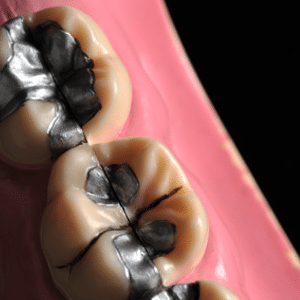 Groups like the American Medical Association and the FDA that advocate the use of mercury fillings, also known as silver fillings or amalgam, acknowledge that mercury is a toxic heavy metal that can cause neurological problems, but they still insist that it is safe to use as a tooth filling for cavities. These fillings release mercury vapor each time a person chews on them, causing the body to inhale and absorb this toxic vapor. Eighty percent of this vapor accumulates in the body’s tissues because the body is unable to effectively excrete it.
Groups like the American Medical Association and the FDA that advocate the use of mercury fillings, also known as silver fillings or amalgam, acknowledge that mercury is a toxic heavy metal that can cause neurological problems, but they still insist that it is safe to use as a tooth filling for cavities. These fillings release mercury vapor each time a person chews on them, causing the body to inhale and absorb this toxic vapor. Eighty percent of this vapor accumulates in the body’s tissues because the body is unable to effectively excrete it.
Mercury is a known neurotoxin, and its exposure is known to cause impaired cognitive skills, tremors and sleep disturbance in people with continued exposure, even at low levels. Even a short duration of mercury exposure can cause chest pain, cough, difficulty breathing, impaired lung function and negative effects to the central nervous system. A group of the world’s top mercury researchers announced in 1998 that mercury from fillings can cause permanent damage to a child’s brain, immune system and kidneys. A pregnant woman’s developing child can accumulate mercury in the brain, liver and kidneys, and mothers can pass mercury to their infants through breast milk. Mercury exposure is also associated with bleeding gums, concentration problems, gastrointestinal problems and memory disturbances.
One study found a link between mercury and Alzheimer’s disease. Researchers exposed rats to mercury vapor, and the rats developed tissue damage like that of the tissue damage of Alzheimer’s disease. The lead scientist performing the study, Dr. Boyd Haley, said, “I’m getting the rest of my fillings taken out right now, and I’ve asked my wife to have hers replaced, too.”
Since scientists agree that mercury is toxic outside of the body, why would it be safe to use in the body? “When you plant a neurotoxin two inches from the brain, can you say no one is ever harmed from that?” said Charlie Brown, director of Consumers for Dental Choice. There are warnings to alert us about the mercury in thermometers and fluorescent lights and to dispose of them as hazardous waste; we learned in biology class not to touch mercury so that it wouldn’t be absorbed into our skin; and certain fish have been declared toxic to eat because of its mercury content.
Another concern with mercury fillings is the environmental damage, like water contamination, caused by this toxic substance. Mercury’s use and disposal is often unregulated in many places, including the United States. The World Health Organization states that mercury from amalgam fillings and laboratory devices makes up 53 percent of total mercury emissions. Denmark, Norway and Sweden have prohibited mercury’s use in fillings because of environmental concerns.
The use of mercury fillings has decreased by 30 percent in the last decade, but according to the American Dental Association, hundreds of millions of people still have them in their mouths. Even today, with all of the information pointing to mercury’s toxicity, dentists still use it to fill cavities of 50 million teeth each year. Dr. Herrmann, at Assure A Smile, does not believe in using toxic fillings made of mercury. An experienced Miami dentist, Dr. Herrmann can safely remove your old mercury dental fillings by taking special precautions to ensure that you do not inhale or swallow any metal particles, while using filters to keep metal from entering the public water system.
Sources for this health report include:
http://www.naturalnews.com/030741_mercury_fillings_FDA.html
http://articles.chicagotribune.com/2011-11-30/health/sc-health-1130-dental-fillings-20111130_1_mercury-fillings-amalgam-consumers-for-dental-choice
http://en.wikipedia.org/wiki/Dental_amalgam_controversy
https://www.assureasmile.com/holistic-dentistry-miami/





